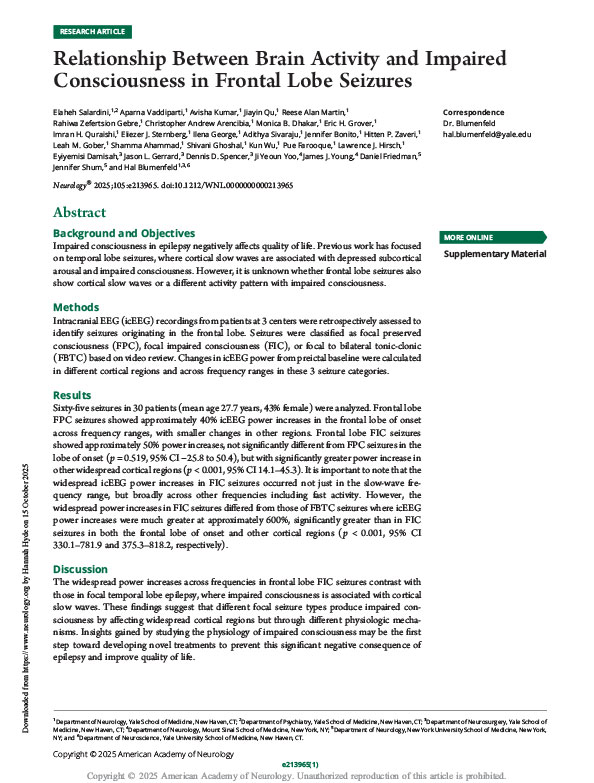Relationship Between Brain Activity and Impaired Consciousness in Frontal Lobe Seizures
September 2025 | Neurology
Abstract
Background and Objectives
Impaired consciousness in epilepsy negatively affects quality of life. Previous work has focused on temporal lobe seizures, where cortical slow waves are associated with depressed subcortical arousal and impaired consciousness. However, it is unknown whether frontal lobe seizures also show cortical slow waves or a different activity pattern with impaired consciousness.
Methods
Intracranial EEG (icEEG) recordings from patients at 3 centers were retrospectively assessed to identify seizures originating in the frontal lobe. Seizures were classified as focal preserved consciousness (FPC), focal impaired consciousness (FIC), or focal to bilateral tonic-clonic (FBTC) based on video review. Changes in icEEG power from preictal baseline were calculated in different cortical regions and across frequency ranges in these 3 seizure categories.
Results
Sixty-five seizures in 30 patients (mean age 27.7 years, 43% female) were analyzed. Frontal lobe FPC seizures showed approximately 40% icEEG power increases in the frontal lobe of onset across frequency ranges, with smaller changes in other regions. Frontal lobe FIC seizures showed approximately 50% power increases, not significantly different from FPC seizures in the lobe of onset (p = 0.519, 95% CI −25.8 to 50.4), but with significantly greater power increase in other widespread cortical regions (p < 0.001, 95% CI 14.1–45.3). It is important to note that the widespread icEEG power increases in FIC seizures occurred not just in the slow-wave frequency range, but broadly across other frequencies including fast activity. However, the widespread power increases in FIC seizures differed from those of FBTC seizures where icEEG power increases were much greater at approximately 600%, significantly greater than in FIC seizures in both the frontal lobe of onset and other cortical regions (p < 0.001, 95% CI 330.1–781.9 and 375.3–818.2, respectively).
Discussion
The widespread power increases across frequencies in frontal lobe FIC seizures contrast with those in focal temporal lobe epilepsy, where impaired consciousness is associated with cortical slow waves. These findings suggest that different focal seizure types produce impaired consciousness by affecting widespread cortical regions but through different physiologic mechanisms. Insights gained by studying the physiology of impaired consciousness may be the first step toward developing novel treatments to prevent this significant negative consequence of epilepsy and improve quality of life.

